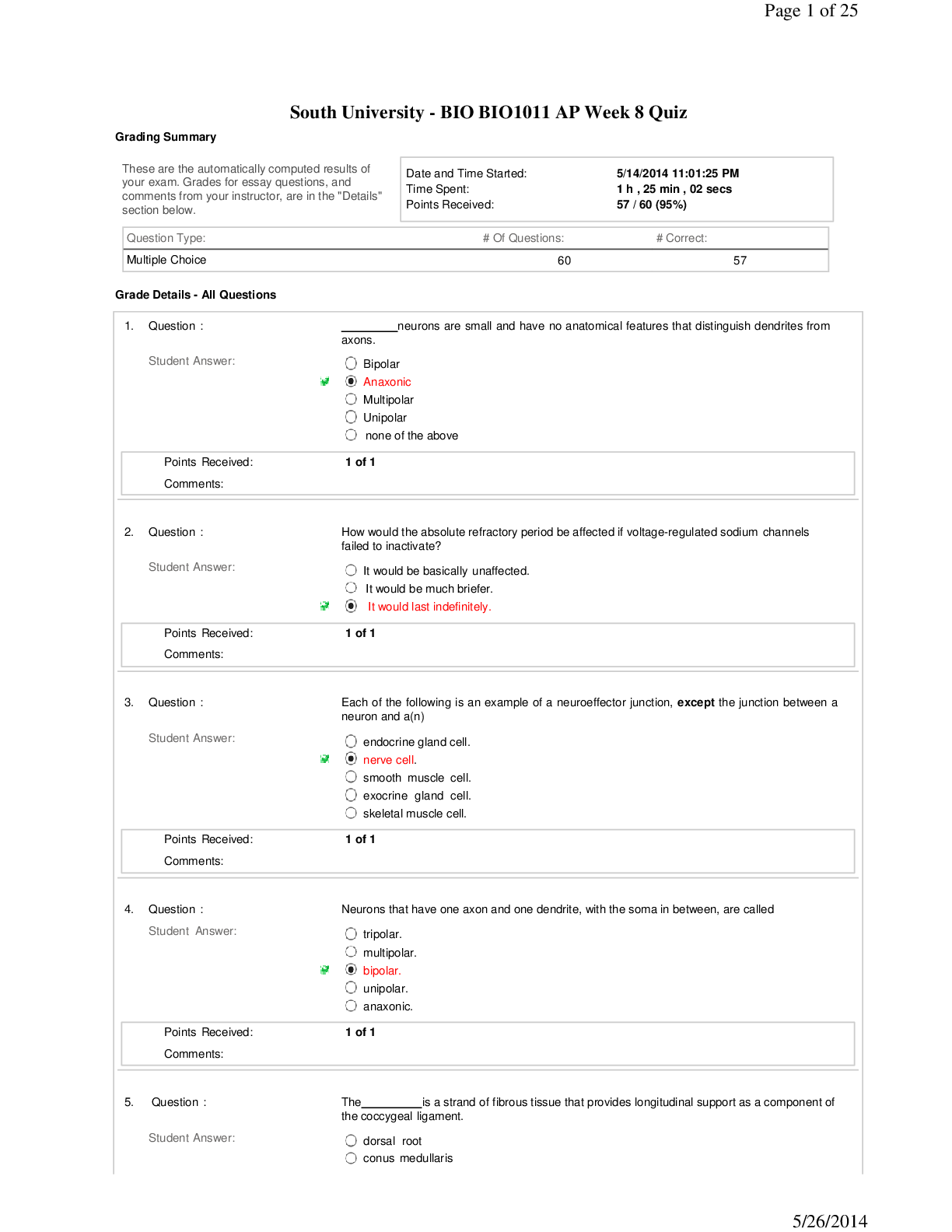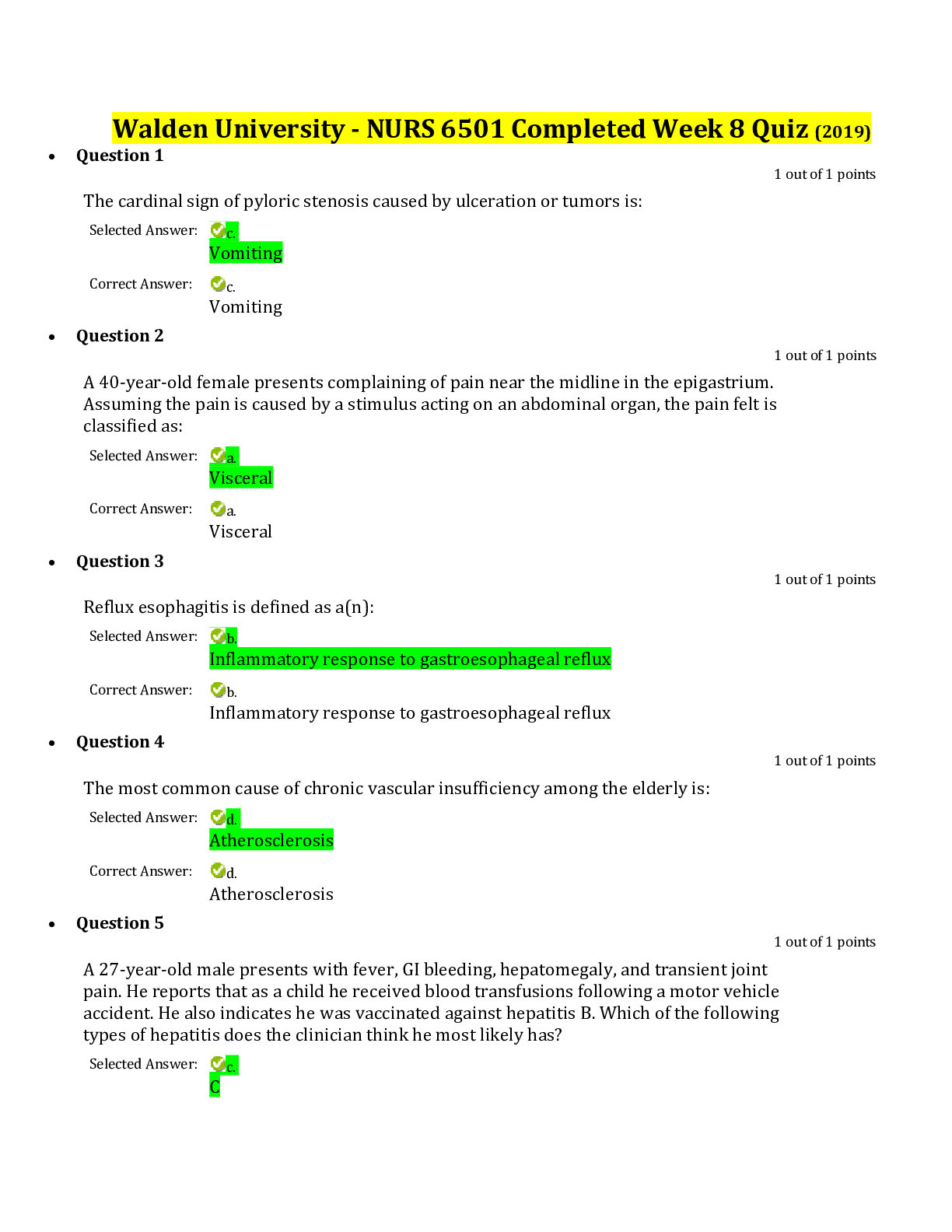*NURSING > EXAM > NURS 6512 Week 8 Quiz latest – Walden University | NURS6512 Week 8 Quiz latest (All)
NURS 6512 Week 8 Quiz latest – Walden University | NURS6512 Week 8 Quiz latest
Document Content and Description Below
NURS 6512 Week 8 Quiz latest – Walden University • Question 1 0 out of 2 points Risk factors for sports-related injuries include: previous fractures. failure... to warm up before activity. • Question 2 2 out of 2 points Injuries to long bones and joints are more likely to result in fractures than in sprains until: adolescence. adolescence. Response Feedback: Fractures to long bones and joints are more common during growth years. During childhood and early adolescence, the epiphyseal growth plates are more easily injured than are the tougher ligaments. Growth is completed with the closure of the epiphyseal growth plates, at about 20 years of age. • Question 3 2 out of 2 points Ligaments are stronger than bone until: adolescence. adolescence. Response Feedback: Ligaments are stronger than bone during birth and infancy. It is not until adolescence that bone becomes stronger. • Question 4 2 out of 2 points The family history for a patient with joint pain should include information about siblings with: genetic disorders. genetic disorders. Response Feedback: An important history to obtain for a patient with joint pain would be family history of genetic disorders such as osteogenesis imperfecta, dwarfing syndrome, rickets, hypophosphatemia, or hypercalciuria. • Question 5 2 out of 2 points Temporalis and masseter muscles are evaluated by: having the patient clench his or her teeth. having the patient clench his or her teeth. Response Feedback: Having the patient bite down and clench his or her teeth is the method to examine the strength of the temporalis and masseter muscles. Cranial nerve V is tested with this same maneuver. • Question 6 2 out of 2 points A 3-year-old is brought to the clinic complaining of a painful right elbow. He is holding the right arm slightly flexed and pronated and refuses to move it. The mother states that symptoms started right after his older brother had been swinging him around by his arms. This presentation supports a diagnosis of: radial head subluxation. radial head subluxation. Response Feedback: The symptoms this child is experiencing is indicative of a radial head subluxation, or nursemaid s elbow. The symptoms are not consistent with femoral anteversion, carpal tunnel syndrome, Osgood-Schlatter disease, or osteomyelitis. • Question 7 2 out of 2 points When performing the drawer test, the examiner would place the patient in a supine position and flex the knee 45 to 90 degrees, placing the foot flat on the table, and then: grasp the lower leg with both hands and draw the tibia forward and then backward. grasp the lower leg with both hands and draw the tibia forward and then backward. Response Feedback: The next step is to place both hands on the lower leg with the thumbs on the ridge of the anterior tibia just distal to the tibial tuberosity. Draw the tibia forward, forcing the tibia to slide forward of the femur. Then push the tibia backward. Anterior or posterior movement of the knee greater than 5 mm in either direction is an unexpected finding. • Question 8 2 out of 2 points Which one of the following techniques is used to detect a torn meniscus? McMurray test McMurray test Response Feedback: The McMurray test points to a meniscus tear. The Phalen test detects carpal tunnel syndrome. The drawer test detects an anterior cruciate ligament tear, the Thomas test detects hip contraction, and the Trendelenburg test detects weak hip abductor muscles. • Question 9 2 out of 2 points The physical assessment technique most frequently used to assess joint symmetry is: inspection. inspection. Response Feedback: The assessment technique most commonly used to assess joint symmetry is inspection. Palpation, percussion, auscultation, and the use of joint calipers are not commonly used for this purpose. • Question 10 2 out of 2 points An adult with bowed tibias and a shortened thorax may have: Paget disease. Paget disease. Response Feedback: Paget disease is characterized by bowed tibias, asymmetric skull, shortened chest, and susceptibility to fractures. • Question 11 2 out of 2 points Expected normal findings during inspection of spinal alignment include: head positioned superiorly to the gluteal cleft. head positioned superiorly to the gluteal cleft. Response Feedback: Spinal alignment is considered within normal limits when the patient s head is positioned directly over the gluteal cleft. The skin folds should be symmetrical, the scapulae are at even heights, and both the cervical and lumbar curves are concave. • Question 12 2 out of 2 points Anterior cruciate ligament integrity is assessed via the _____ test. Lachman Lachman Response Feedback: The Lachman test evaluates anterior cruciate ligament integrity. The straight leg raise test assesses nerve root damage, the valgus stress test assesses instability of the lateral and medial collateral ligaments, the Homan test assesses for blood clots in the legs, the Thomas test is used to detect flexion contractures of the hips. • Question 13 2 out of 2 points Arm length is measured from the acromion process through the: olecranon process to distal ulnar prominence. olecranon process to distal ulnar prominence. Response Feedback: Total arm length is assessed by the standard measurement of the length from the shoulder (acromion process) through the elbow (olecranon process) joint to the wrist (distal ulnar prominence). • Question 14 2 out of 2 points What technique is performed at every infant examination during the first year of life to detect hip dislocation? Barlow-Ortolani maneuvers Barlow-Ortolani maneuvers Response Feedback: At every examination during an infant s first year of life, the Barlow-Ortolani maneuver is performed. This test involves stabilizing the pelvis and flexing one hip and knee to 90 degrees. It detects hip dislocation and is signified by a clicking noise with the maneuver. • Question 15 2 out of 2 points A 45-year-old laborer presents with low back pain, stating that the pain comes from the right buttock and shoots down and across the right anterior thigh, down the shin to the ankle. Which examination finding is considered more indicative of nerve root compression? Contralateral straight leg raise Contralateral straight leg raise Response Feedback: This patient, according to the pattern of radiculopathy, has an L3-L4 injury to the right side. The most alarming finding would be crossover pain to the affected leg while raising the unaffected leg, because this finding is more suggestive of herniation. • Question 16 2 out of 2 points Dupuytren contracture affects the: palmar fascia. palmar fascia. Response Feedback: A contracture of the palmar fascia of one or multiple fingers is called a Dupuytren contracture. • Question 17 2 out of 2 points When the shoulder contour is asymmetrical and one shoulder has hollows in the rounding contour, you would suspect: dislocated shoulder. dislocated shoulder. Response Feedback: Asymmetrical contours to the shoulder with a hollowing in the socket are symptoms of a shoulder dislocation. Kyphosis is a condition of the back; muscle wasting, dislocated elbow, and a scapula fracture do not present with these symptoms. • Question 18 2 out of 2 points A red, hot swollen joint in a 40-year-old man should lead you to suspect: gout. gout. Response Feedback: Gout is characterized as red, hot swollen joints, especially the great toe. Gout is commonly linked to men older than 40 years. • Question 19 2 out of 2 points A patient presenting for the first time with typical low back pain should receive which of the following diagnostic tests? None of the above. X-ray is not indicated because lumbar pain is usually of musculoskeletal etiology. None of the above. X-ray is not indicated because lumbar pain is usually of musculoskeletal etiology. • Question 20 2 out of 2 points A 7-year-old boy is brought into your office with a chief complaint of possible fracture in his left third finger. He jammed it while playing basketball 2 days ago. The mother states that she really does not think it is broken because he can move it. What is your best response? This is a common misconception, and the finger may be broken. An x-ray is indicated. This is a common misconception, and the finger may be broken. An x-ray is indicated. [Show More]
Last updated: 2 years ago
Preview 1 out of 11 pages

Buy this document to get the full access instantly
Instant Download Access after purchase
Buy NowInstant download
We Accept:

Reviews( 0 )
$12.50
Can't find what you want? Try our AI powered Search
Document information
Connected school, study & course
About the document
Uploaded On
Nov 14, 2020
Number of pages
11
Written in
Additional information
This document has been written for:
Uploaded
Nov 14, 2020
Downloads
0
Views
62








 – University of the People.png)

















